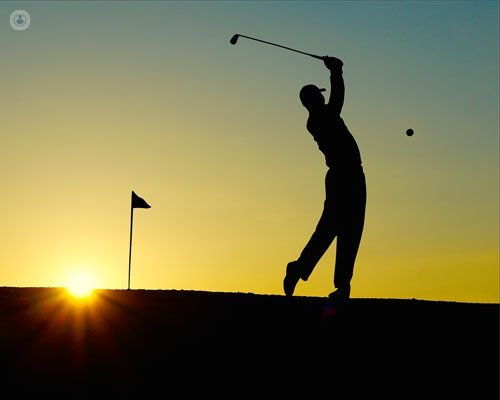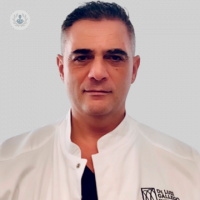What you need to know about injuries in golf
Written by:Regular practice of golf has many health benefits and improves quality of life, because it is an aerobic exercise that is practiced outdoors and positively modifies cardiovascular and cerebrovascular health:
- The walking tour is 5-8 km, which means an expense of about 400-500 calories carrying sticks or about 300 calories if the cart is pushed.
- The swing (series of movements that are made to give the ball with the stick) makes exercise both muscle power as the aim, so it works both strength and coordination, the latter being beneficial for the brain.
However, this sport also carries risks of injury that must be taken into account. Although it may be thought that it is difficult to be injured playing golf, keep in mind that it is a sport that requires several muscle contractions to produce complex movements in the swing, you need to activate more than 60 muscles and numerous joints and can reach a speed more than 150 km / h in less than 20 tenths of a second to hit the ball. This whole process is an effort which, if not carried out properly, acute injury or overuse injury can occur.

When and how injuries occur in golf?
In the first phase of the swing, usually occurs hyperextension of the arms at the end of rolling, so that can trigger epicondylitis ( "golfer 's elbow") or epicondylitis ( "tennis elbow").
Another injury that can occur is an overload of the lumbar muscles or lumbosacral junction. This is due to a rotation and de-rotation of the lumbar spine whose strength can damage the paravertebral muscles, the vertebral ligaments, facet joints or intervertebral disks.
In the final phase of the backswing (action of pulling the stick back to gain momentum), many people rise too arms, so that the tendons of the rotator cuff of the shoulder down compressed into bone acromion and can damage them if repeated the movement.
If the stick hits the ground by mistake and not the right to try to give the ball stick is attached, can cause damage to the wrist, especially in the hamate bone, and strain or tear in the muscles "core" (lumbar, abdominal, hips and scapular stabilizer) if it is not properly toned.
Finally, in the final phase of the swing gradually slows the movement, which can damage the tendons of the right shoulder or the thoracolumbar spine or cause an overload of ankle and knee.
How can you prevent injuries in golf?
It is important to follow the following tips from traumatologist to avoid injury while playing golf:
- Undergo a medical examination to assess the points susceptible to injury and treat. The main areas to consider are the shoulders, elbows and back in the lumbar area.
- Correct technique to minimize the risk of injury caused by sudden and repeated overexertion.
- Practice aerobic sports (running, swimming, walking, cycling, etc.) to be in good shape.
- Warm up before you start playing. First, mobilization exercises the whole body, beginning with the cervical area and ending at the ankles. After making specific movements progressively increasing swing speed and, if possible, with increasingly long sticks, which stimulates muscle memory and improves performance.


